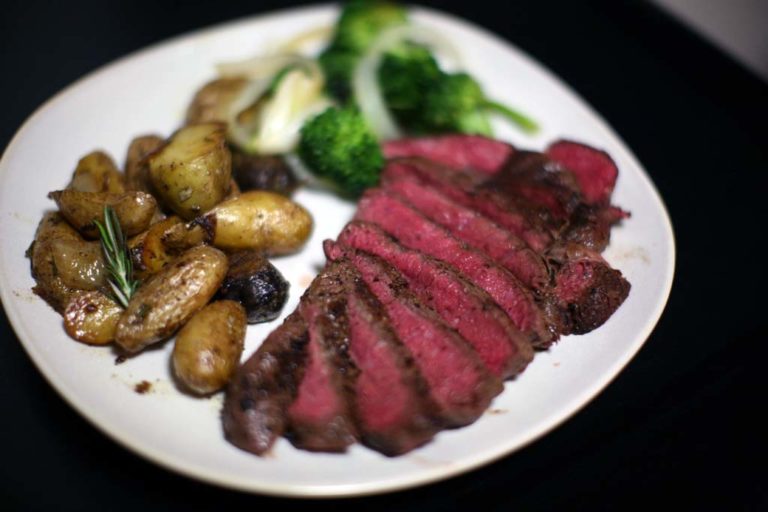
Chef's notes:
For my birthday one year, my very best friends gave me two Kobe beef ribeyes. That very day we happened to be grilling. But since we already had strip steaks on the grill, I put them in the fridge to save for the next day. The next day, I had to work and I didn’t get home until almost 10 o’clock. But I had been thinking about those steaks all day and was determined to eat them that night. So I walked right through the house and out the back to fire up the grill. I was very excited about tasting the meat I had heard so much about.
I grilled them to rare with salt and pepper. The first bite disappeared in my mouth almost as soon as it landed. The second bite was mostly fat, but I noticed that the fat was really flavorful. The meat was delicious. The major difference was in the fat; it was the best beef fat I had ever tasted.
Ingredients
- 1 lb Kobe top sirloin
- Sea salt
- Black pepper
- Butter
Top Sirloin Kobe Beef Steak: Sea Salt and Black Pepper, then Pan-Fried in Butter to Medium-Rare
- Make sure the steaks are a manageable size to fry in the pan. A good rule to remember when pan frying meat is to have twice as much pan as meat. This will give the steak enough surface area and heat to adequately brown the meat. My 1 pound of top sirloin was cut into two nice steaks, but were a little big for my all-clad pan. So I cut them in half. Season your steaks while heating the frying pan on the stove top at a couple clicks past medium heat. Coat the pan with a little vegetable oil or butter.
- Once the pan is hot, put the steaks in the pan and preheat the oven to 450 degrees F. Make sure to leave some space in between the steaks so that the pan doesn’t cool down too much. Too much meat in the pan and you will wind up boiling them in their own juices instead of frying them. There will be some smoke produced, and this is a natural by-product of applying lots of heat to something. After about a minute, flip the steak over onto the unused portion of the pan. After another minute, remove to a plate and cover with aluminum foil. Continue the process with the other steaks. Turn off the heat and remove the pan from the stove once you have finished.
- After browning all the steaks, return them to the pan and mount them with butter. The steaks are still pretty warm and may have rested a bit on the plate. If there are juices on the plate, dump them in the pan too. Put the steaks back in the pan and top them with a little dab of butter. If you like your steaks rare, they are done. After a few more minutes’ rest, they will be ready to be eaten. If you prefer your meat to be more well done than rare, continue with the next step.
- If you want the steaks cooked beyond rare, finish them in the oven. Put the frying pan with the butter-mounted steaks into the preheated oven. Use the following temperature guidelines to determine when to take your steak out: for rare meat 120–125 degrees, medium is 140–150 degrees, and well done is around 160–170 degrees. A digital thermometer will be the most accurate method of testing temperatures. Do me a favor—don’t cook Kobe past 150 degrees. It would be a total waste.
Tips & Tricks
- Kobe beef is meat from the Wagyu breed of cattle. When the cattle live in Kobe, Japan, it is called Kobe beef. Just like sparkling wine from Champagne, France, is called Champagne. So, if you are looking for Kobe beef but all you can find is Wagyu, just use the Wagyu. Also, shop around and find out who is giving the best deal. Sometimes they may have discounts on certain days of the week. My local place has 20% off Kobe beef on Mondays, so I buy it on Monday. Like twice a year!
- Any sort of skillet will cook steak, but it is best to use something that will hold onto lots of heat. Cast iron is fabulous to cook with. It requires a little maintenance but not too much. All clad, or anything with a thick bottom, is a great option. Non-stick is preferred for some things, but cooking steaks is not one of them. The nice thing about the stuff that sticks to the bottom is you can use it to make a quick steak sauce. Just deglaze with some broth and scrape off the bits, add some Worcestershire sauce, black pepper, and maybe a spot of red wine, reduce, taste, adjust, eat, and enjoy. Mix it up!
